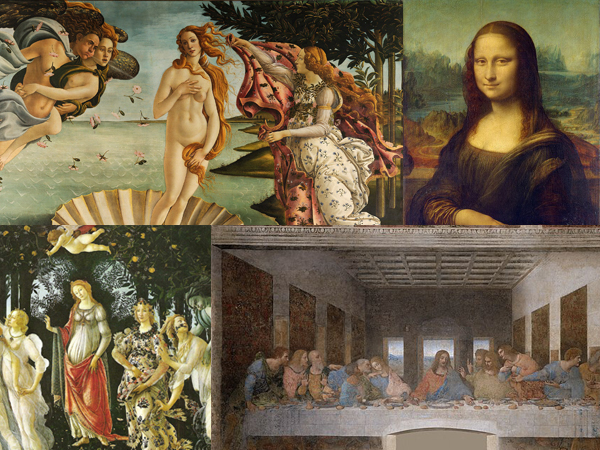
The Renaissance was a period of profound cultural, artistic, and intellectual activity that marked the transition from the Middle Ages to modernity. Originating in Italy in the 14th century and spreading across Europe until the 17th century, the Renaissance is best known for its artistic developments and the contributions of polymaths such as Leonardo da Vinci and Michelangelo, who inspired the term “Renaissance man” for their unquenchable curiosity and vastly diverse talents.
Key characteristics and developments of the Renaissance include:
- Revival of Classical Antiquity: There was a renewed interest in Greek and Roman literature, philosophy, and art. This revival was reflected in all aspects of culture, especially in the arts, where classical forms and themes were emulated and adapted to express Renaissance ideals.
- Humanism: The intellectual movement known as humanism placed a greater emphasis on the study of human needs and interests. Scholars studied classical texts to understand ancient values and philosophies, which they then applied to their own times, focusing on human potential and achievements.
- Innovations in Art: The Renaissance saw revolutionary developments in art, including the use of perspective to achieve depth and realism, the study of human anatomy to improve the depiction of the human figure, and the application of innovative techniques in painting, such as sfumato and chiaroscuro. These advancements allowed for more lifelike and dynamic compositions.
- Scientific Discoveries and Inventions: The period was marked by significant progress in science and technology. The printing press, invented by Johannes Gutenberg in the 15th century, revolutionized communication and helped disseminate knowledge. Advances were also made in astronomy, physics, and anatomy.
- Exploration: The Renaissance era was a time of exploration. Inspired by the desire to find new trade routes and driven by a curiosity about the world, European explorers traveled to Africa, the Americas, Asia, and the Pacific. These explorations had profound implications for European and world history.
- Political and Social Changes: The Renaissance period also witnessed changes in political structures and social order. The emergence of nation-states, the decline of feudalism, and the rise of powerful monarchies and city-states in Italy changed the landscape of European politics.
The Renaissance laid the foundation for the modern world through its emphasis on the importance of the individual, its explorations of new territories, both intellectual and geographic, and its unparalleled achievements in art, literature, and science. Its legacy is seen in the continued admiration for Renaissance art, the enduring influence of its thinkers, and the foundations it laid for future intellectual and cultural movements.
Here are some of the most famous paintings from the Renaissance period:
- Mona Lisa by Leonardo da Vinci – Probably the most famous painting in the world, the Mona Lisa is renowned for its mysterious subject’s enigmatic smile. It was painted between 1503 and 1506, and it currently resides in the Louvre Museum in Paris.
- The Last Supper by Leonardo da Vinci – This mural painting, created from 1495 to 1498, depicts Jesus and his disciples during the moment he announces that one of them will betray him. It’s notable for its emotional depth and use of perspective.
- School of Athens by Raphael – A masterpiece of High Renaissance art, this fresco, painted between 1509 and 1511, represents the gathering of the greatest minds of antiquity in an idealized classical setting, showcasing Raphael’s skill in perspective and composition.
- The Creation of Adam by Michelangelo – Part of the Sistine Chapel ceiling painted between 1508 and 1512, this iconic image depicts God giving life to the first man, Adam, with a touch of their fingers. It’s celebrated for its depiction of human beauty and divinity.
- The Birth of Venus by Sandro Botticelli – Painted in the mid-1480s, this painting depicts the goddess Venus emerging from the sea as a full-grown woman. It’s renowned for its beauty, graceful lines, and the use of mythological subject matter.
- Primavera by Sandro Botticelli – Also known as “Allegory of Spring,” this painting is filled with symbolic figures from classical mythology in a garden. It’s admired for its intricate detail and the depiction of idealized beauty.
- The Arnolfini Portrait by Jan van Eyck – While the Northern Renaissance is distinct from its Italian counterpart, this work is a key piece of the period. Painted in 1434, it’s celebrated for its extraordinary detail, use of oil paints, and complex symbolism.
- The Baptism of Christ by Leonardo da Vinci and Andrea del Verrocchio – This painting is a collaborative work that showcases the transition from the Early to the High Renaissance, highlighting the innovative use of perspective and realistic depiction of human figures and landscapes.
- The Annunciation by Leonardo da Vinci – A masterpiece depicting the moment the Angel Gabriel announces to Mary that she will bear the Son of God, celebrated for its emotional expression and detailed landscape.
- Sistine Madonna by Raphael – Famous for its depiction of the Madonna and Child with Saints Sixtus and Barbara, this painting is notable for its heavenly perspective and the iconic cherubs at its base.
These masterpieces not only exemplify the artistic genius of their creators but also reflect the intellectual and cultural vibrancy of the Renaissance. They continue to fascinate scholars, art lovers, and casual viewers alike, centuries after their creation.